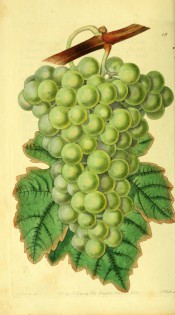Vitis vinifera ‘Chasselas’
‘Bunches, long, loose, and shouldered; sometimes compact and cylindrical. Berries, large, round, and, in the compact bunches, inclining to oval. Skin, thin and transparent, greenish yellow, becoming pale amber when quite ripe, and sometimes marked with tracings and dots of russet; covered with thin white bloom. Flesh, tender and juicy, sweet, and richly flavoured.’ [Hogg – Fruit Manual p.404/1884].
Horticultural & Botanical History
‘One of the commonest and oldest of our Grapes, having been cultivated as long as we have any distinct record. It is chiefly valuable on account of the certainty with which it ripens in the open air, either on south walls or upon bushes trained in the vineyard fashion, in favourable situations. In this latter manner, a very considerable crop of fruit is annually obtained by Mr. Joseph Kirke in his Nursery at Brompton, where the accompanying drawing was made last year. In almost all seasons it will ripen upon walls in our southern and midland counties; and in warm autumns acquires a rich and excellent flavour. For the purposes of the English wine-maker, it is better adapted than any other white variety.
The usual period of maturity is the middle of September; and the bunches will hang upon the vines, if the season be favourable, till the beginning or middle of November.
It will be observed, that the Chasselas de Fontainebleau Grape of the French, which is usually considered the same as the Common Muscadine, is not included in its synonyms. It is undoubtedly true, that in the fruit no perceptible difference exists, either in appearance, quality, or time of ripening; but they do differ in this, that while the leaves of the under surface, those of the Chasselas de Fontainebleau are downy. It must, therefore, be borne in mind, that while they are similar in all points of importance, they are not identically the same.
So much confusion exists in the application of the term White and Royal Muscadine, that it is sometimes difficult to know what is really meant by the names of authors, when the fruit is slightly described. The term Royal Muscadine is frequently applied to this; but it is very clear that Miller intends by that designation the old White Muscadine, described by Parkinson as frequently weighing six pounds the bunch. Speechly also meant the same by his Royal Muscadine, or D'Arboyce. It is, therefore, better to abandon the name Royal Muscadine, to call the present variety the Common Muscadine, and to apply the name of White Muscadine in the sense of Parkinson.’ [PM t.18/1828].
‘This excellent and well-known grape ripens well in a cool vinery, and against walls in the open air. The many names it has received have arisen from the various forms it frequently assumes, and which are occasioned entirely by the nature of the soil and the different modes of treatment to which it is subjected. There is no real difference between this, the Common Chasselas, and Chasselas de Fontainbleau. The White Muscadine of some authors is the Early Chasselas.’ [Hogg – Fruit Manual p.404/1884].
‘Chasselas Napoléon’ is figured in Album de Pomologie [ADP vol.1 t.25/1847-1851]. This variety appears to have been introduced in 1847.
History at Camden Park
Listed in all published catalogues as ‘Chasselas’ [Vines for Table Only no.8/1843]. ‘Chasselas’ is probably best thought of as a name for a reasonably well defined family of grapes rather than as a specific variety.
Notes
Published Jun 23, 2010 - 12:24 PM | Last updated Jul 21, 2011 - 12:42 PM
| Family | Vitaceae |
|---|---|
| Category | |
| Region of origin | Garden origin, unknown, probably France |
| Synonyms | |
| Common Name | Grape, Table Grape |
| Name in the Camden Park Record |
Chasselas
|
| Confidence level | high |


